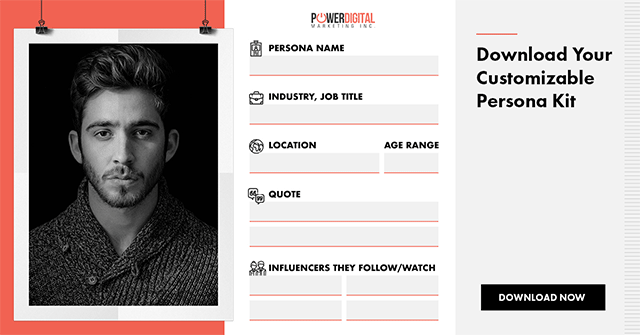Buyer Persona Guide in Your Content Marketing Strategy
So you’ve created your buyer personas, now you are probably wondering “How do I use personas?” Continue reading our buyer persona guide to see some great marketing strategies to make sure you’re fully utilizing your user personas. But first, let’s make sure you created your customer personas:
Developing Buyer Personas
If you have read my last post and created your personas, or have created your user personas on your own, you’re ready to put them to good use with this step-by-step guide! (However, it will still be helpful download the PDM B2C Persona Template so that the examples make sense.)
Step 1: Create Long-Tail Keywords
Take a look at your persona’s Purchase Decisions, Social Behavior, and Shopping Preferences. You should have also filled out your marketing Strategic Plan for your ideal customer, but we’ll get to that. Come up with a list of long-tail keywords for each bullet in the purchase decision section. For example, in our PDM B2C Persona Template I can see that Example Erin loves products that are easy to use. If your product is kitchen supplies, a great longtail keyword would be “easy to use kitchen supplies.” Build out this list as best you can.
Step 2: Research Keywords
Check out the search volume of these long tail keywords, you can use the AdWords Planning Tool, I personally like to use that tool in addition to HubSpot’s Keyword Tool, since I have an account. Even if the search volume is only 50 per month or so, that’s okay! That could be 50 new potential customers. Organize your keywords and figure out where you have the most opportunity. You also may want to shy away from general keywords that are too competitive, it could be difficult to rank for these.
Step 3: Content Strategy
Write content related to that long tail keyword. Chances are, your persona is already searching for it. Don’t make this content too salesy, your persona is likely in the awareness phase of their buyer cycle and is just looking for general information at this point in time. If we’re continuing with the kitchen supply example, maybe your first post would be “5 Easy To Use Kitchen Suppies You Didn’t Know You Needed.” Doesn’t that sound relevant to what Example Erin may be looking for? Make sure this post is optimized for your long-tail keyword, but still sounds conversational. You can be more optimized and less conversational in your title tag, which may sound more like “Kitchen Supplies That Are Easy to Use”.
Step 4: Promote
Now it’s time to promote! Looking at Example Erin, we can see that she is very active on Facebook. Promote this blog post there. That way, even if she’s not proactively searching for this type of post, we can still reach her with something of interest. To get your brand name out there, it would be good to post this particular blog post on Facebook, and then boost that post to extend your reach.
Step 5: CTA
So at this point we have Example Erin’s attention, we’ve compelled her to read the article and we’ve added value. So what’s next for Example Erin? A call to action! This is a great way to guide Example Erin down the sales funnel. Otherwise, she will read the article and then leave forgetting all about your company, especially if she found you organically. By compelling her to subscribe to your blog, or to complete a form to get a related downloadable piece of collateral, you’ve started a conversation and can continue to add value and stay top of mind.
Step 6: Nurture
Now is the time to nurture Example Erin with more high-quality content that is relevant to her. You know what she is interested in and what she is looking for, so use that. Promote the next article you wrote based on her long-tail keyword list, or send her an exclusive coupon, which we know she would value based on her shopping preferences. Whatever keeps the conversation going. The more relevant you stay, the more you add to Example Erin’s LTV as a customer.
Planning And Refining Your Content Strategy
Of course these six steps sound easy on paper, but they take a lot of planning and work, so be ready for that. Additionally, with persona development make sure to keep adding information to your personas as you learn more about them so you can get more focused on your target audience as time goes on.
If you have any questions about our buyer persona guide, or want me to create a template for your industry, please ask in the comments and I’ll be sure to answer, and make sure to subscribe to our blog on the right to keep getting great insights.



















